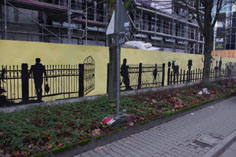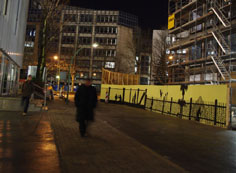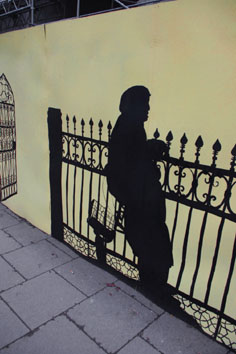| Zaun
mit Zwischenraum
Acryl auf
Holz, 220 x ca 16000 cm, Frankfurt/Main
Courtesy siebenhaar art projects,
Königstein Ts. / Frankfurt
am Main
(Fense with clearances)
2011, acrylic on wood, 220 x 16000 cm, Frankfurt/Main
Courtesy siebenhaar art projects,
Königstein Ts. / Frankfurt am Main
|
|
Zaun
mit Zwischenraum ist die Bemalung eines Bauzaunes,
der sich um das Gebäude mit dem Namen Occidens in Frankfurt
am Main zog. Die Arbeit setzt den Begriff Occidens ins Verhältnis
zu seinem historischen Gegenstück Orient. Der Bezugspunkt
ist Goethes Westöstlicher Divan. Das Buch ist in zwölf
Kapitel oder ‚Bücher’ eingeteilt, die ihre Entsprechung
in Form von zwölf Zaunmustern finden. Goethes Begeisterung für
die Gedichte des Persers Hafez und die Auseinandersetzung mit der arabischen
Kultur und dem Islam fanden im Buch ihren Niederschlag. Der Gedichtzyklus
von 1819 liegt am Beginn des Orientalismus und ist ein wichtiger Moment
in der Beschäftigung der beiden Kulturkreise miteinander, die schon
seit dem römischen Reich andauert.
Auf dem Bauzaun verschmelzen Ornamente aus den Kulturen in der Übereinanderblendung
und entwickeln sich zu neuen Formen weiter. Sie bilden eine Kulisse für
die realen Passanten.
Verwendet wurden funktionale und dekorative Muster und Formen gleichermaßen:
Mashrabiyas, schmiedeeiserne Zäune bis zu Grenzzäunen und Maschendrahtzaun
fanden Verwendung.
Der Zaun
kommt seiner ambivalenten Funktion nach: er unterscheidet, trennt, isoliert
oder gibt Form.
Fence
with Gap
Fence with Gap referred to a site fence in Frankfurt’s West End,
which extended around a building with the name Occidens. The temporary
work takes up the building’s name and places the term Occident in
relation to its historical counterpart, Orient.
Orient and Occident are also the poles which Goethe, as citizen of Frankfurt,
examined in his West-Eastern Divan. Goethe’s enthusiasm about the
poems of the Persian Hafiz, and his involvement with Arabian culture and
Islam, left their mark in the book. This cycle of poems from the year
1819 dates from the beginning of Orientalism, and it is an interesting
moment in the long preoccupation with each other of both cultural spheres.
The fence is shaped in analogy to the twelve chapters into which Goethe
divided the Divan. The nearly 160-meter-long fence is structured by different
fence ornaments, which subdivide and connect the twelve chapters with
one another. Functional and decorated forms from Western and Eastern culture
are employed: Mashrabiyas, wrought-iron fences, as well as picket fences
and fences of wire mesh.
On the site fence, they meld and develop further into new forms. The fence
forms a backdrop for the real passersby. Men, women, and children, as
silhouettes, walk up to the front of the fence and refer, in a playful
way, to the togetherness and coexistence of cultures.
|







